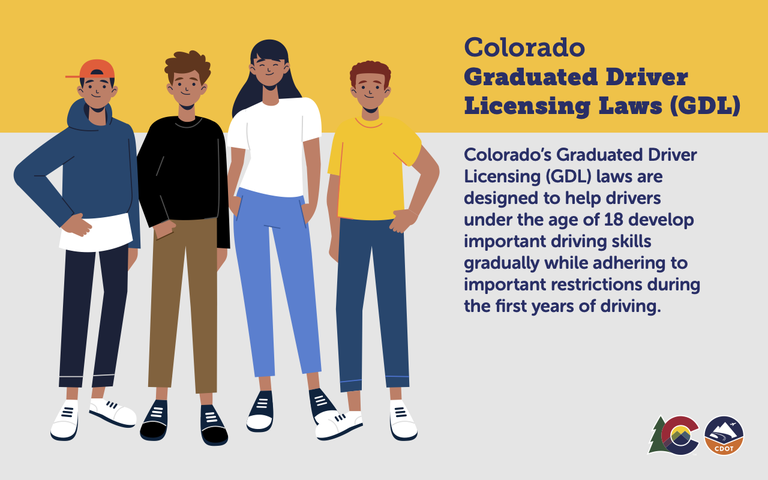Colorado Teen Driving

Understanding Colorado's Graduated Driver Licensing (GDL) Laws
Graduated Drivers Licensing (GDL) laws are designed to keep drivers under 18 safe by limiting distractions and high-risk driving situations while they gain experience. Since the passage of GDL laws, fatal crashes involving drivers aged 16-17 have declined significantly — by nearly 50% over the past 20 years.
However, seat belt use remains a critical issue among teen drivers. In 2019, 45% of teen drivers who died in crashes were unbuckled. When the teen driver was unbuckled, nine out of 10 passengers who died were also not wearing their seat belts.
Continued education and enforcement of GDL laws remain essential for maintaining these safety improvements.
Access the Colorado GDL Toolkit to learn more.
The Driver’s Seat
CDOT and the Colorado Young Drivers Alliance are committed to keeping teens safe by providing valuable resources for parents, teens, schools and safety advocates.
Safety Advocates in Colorado — such as educators, local health departments, law enforcement and other safety-based organizations — have made great strides in improving teen driving safety.
As new teen drivers take to the road every day, it remains essential to continue these safety conversations. Below is information for safety advocates, including tips and tools to help spread the message about safe teen driving.
- Fatality Analysis Reporting System
- The Fatality Analysis Reporting System (FARS) contains data on all vehicle crashes in the United States that occur on a public roadway and involve a fatality.
- U.S. Census Bureau
- Insurance Institute for Highway Safety (IIHS)
- The IIHS and The Highway Loss Data Institute conduct scientific studies of insurance data showing the human and economic losses resulting from the ownership and operation of different types of vehicles. They also publish insurance loss results by vehicle make and model.
- Teen Driver Source Stats & Facts
- A program of the Children’s Hospital of Philadelphia’s Research Institute providing general teen driving stats and charts.
- CDOT Safety Data
- Provides data and information from CDOT’s Office of Transportation Safety, including the Problem Identification Report, survey results and the state’s Integrated Safety Plan.
When your teen starts driving, it’s natural to feel both excited and concerned. Understanding the licensing process and GDL laws can help you guide your teen toward safe driving habits.
- Learn about the Colorado teen driver licensing process.
- Review Colorado’s teen driving laws.
Setting Ground Rules
As a parent, you shape your teen’s driving behaviors. Establishing clear rules — no cellphones, no passengers, no speeding, no alcohol or drugs, no driving while tired and always wearing a seat belt — can save your child’s life and others.
For more tips, visit NHTSA’s Teen Driving Safety webpage. The CDC’s Parent-Teen Driving Agreement is another useful tool.
Getting your driver’s license is an exciting milestone, and it comes with great responsibility. Drivers under 18 are subject to specific driving rules and regulations. Make sure you understand what’s required and how to stay safe on the road.
- Follow the proper steps to get your Colorado driver’s license.
- Understand Colorado’s laws for teen drivers.
